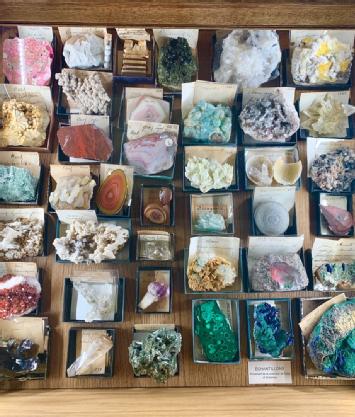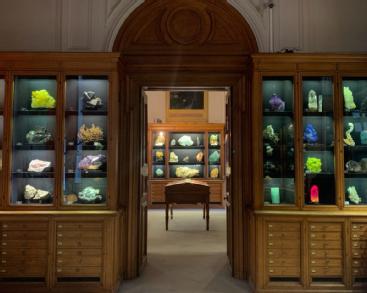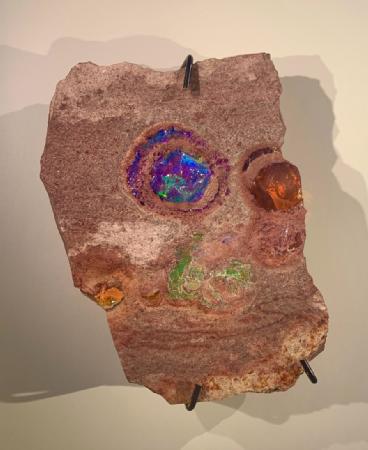Exhibition Review: Collectible Minerals at Mineralogy Museum of Mines Paris – PSL
Published: 24 January 2024 - Anaïs Walsdorf
Whenever I visit mineralogical displays in natural history museums, I can’t help but be in awe at the extraordinary diversity of colours, textures, and shapes that the Earth produces in its subterranean laboratory. Mineralogical collections can be both aesthetically stunning and scientifically fascinating.
At the same time, these displays can hide the troubling histories that lie behind many mineralogical collections. As Subhadra Das and Miranda Lowe argue in their influential 2018 article, Nature Read in Black and White: decolonial approaches to interpreting natural history collections, “science museums, including museums with natural history collections, have positioned themselves at the ‘hard science’ end of the spectrum… A key part of this positioning involves distancing the practice of science from its history”. This is done in part through the ways in which the minerals are curated, displayed, and interpreted.
Default organisation by taxonomies can hide the human and environmental narratives that underlie their extraction and acquisition.[1] Each and every specimen has its own history– it was mined and collected by specific people, under specific environmental, political, economic and social contexts. Furthermore, each individual specimen’s history fits into larger histories of collecting and the creation scientific knowledge and meaning. Large European mineralogical collections from the 18th – 20th centuries often contain specimens from all over the world collected through transnational networks. These networks were key in forming modern European geological sciences, and the public display of the specimens they facilitated served as symbols of imperial power over nature, territory, and populace of national and foreign lands and resources. [2] In fact, one of Napoleon’s imperial projects included acquiring mineral collections from regions occupied by the French to integrate them into Paris’ Musée d'Histoire Naturelle.[3]
 |
Selection of minerals in the Collectible Minerals Exhibition |
So how can mineralogy museums better engage the public with the human histories in their collections? A new exhibition at the Mineralogy Museum of Mines Paris – PSL attempts to address this challenge. In October, I went to Paris to visit the museum’s new ‘Collectible Minerals’ exhibition, whose stated goal is to reveal the human stories behind its acquisitions. Opened in 1794 as the Cabinet des Mines, the Mineralogy Museum of Mines boasts a mineralogical collection of over 100,000 specimens including minerals, rocks, gems, ores, meteorites, and artificial crystals. The Museum was created by public decree to support the Paris School of Mines as a physical catalogue of the Earth and repository of national and colonial geological specimens. In my own research, I study the British equivalents of these two institutions – the Royal School of Mines and adjoining Museum of Practical Geology. In both the French and British national contexts, these were central to the development of national and colonial geological knowledge.
 |
Entrance to the Mineralogy Museum of Mines Paris |
Entering the Mineralogy Museum of Mines Paris feels like stepping backwards in time into the 19th century; dark wooden cabinets line the narrow galleries, displaying rows and rows of glistening specimens from all over the world. The museum’s collections are organised by the traditional scientific classification of minerals based on chemical composition, but the Collectible Minerals exhibition’s bright labels throughout the gallery disrupt this taxonomic status quo. The temporary labels engage visitors with the collection’s history through six themes: field collection, purchase, seizure, donations, heritage, and exchange. Each section highlights the histories of specific specimens within the collection through archival material, maps and plans, and illustrations and art. This peek into the history of the collection reveals underlying themes of global connection, including imperial collecting and transnational exchanges.
Many European mineralogical collections from the 18th – 20th centuries are global in scope and share similar stories of acquisition, including national and colonial geological surveying, international exhibitions, purchases from dealers, and donations from wealthy patrons. Here, I would like to highlight how the Collectible Minerals exhibition drew attention to the specific French context of the collection through the themes of seizures and exchange.
The ‘seizures’ section of the exhibition addresses the redistribution of mineralogical collections during the French Revolution. As part of the process of nationalising the biens nationaux, or national goods, revolutionaries confiscated properties and assets from members of the French monarchy, aristocracy and clergy. One collection was confiscated from Henri Bertin (1720-1792), a minister who had been planning the creation of a French School of Mines. During the 18th century, aristocrats such as Bertin were fond of building private collections composed of natural history specimens and art. Bertin was an Orientalist fascinated with China who, through his political career, sent gifts to the emperor of China with the goal of establishing a relationship of exchange between the two nations. This is reflected in his collection, which includes many Chinese specimens and art objects. In an ironic twist of fate, Bertin’s own mineralogical collection was confiscated during the French Revolution and incorporated into the new mining museum’s collection. Such seizures facilitated the redistribution of these private rich, global collections to French public institutions.
 |
Sculpture from the Bertin collection |
The ‘exchange’ section focused on the 20th century global exchange system in which specimens were assigned a value on an internationally recognised point scale based on their rarity, perfection, and geographical origin. This system, put into place by the Paris School of Mines in agreement with the French Geological Survey in 1957, facilitated the trading of specimens among collectors and institutions across the globe for other minerals of equal value. During the 25 years that the system was used, the museum acquired some of its most stunning and valuable specimens. One opal-bearing rhyolite from Mexico (pictured below) was acquired in exchange for six other minerals. It was obtained from Bernard Amster, director of the French colonial Compagnie de Madagascar and member of the Société Française de Minéralogie et de Cristallographie. Other minerals were traded with institutions such as the Bergakademie in Feiberg, Germany’s first School of Mines, and London’s Royal School of Mines. These global mineral trading networks spread both physical specimens as well as knowledge about the natural world.
 |
Opal-bearing rhyolite from Mexico |
The Collectible Minerals exhibition has played an important step in bringing collection histories to the public. It has provided a fascinating look into the role of the Paris School of Mines and its museum within the context of 18th – 20th century global networks of geology. The exhibition’s shortcoming is its centring of the European men who donated, exchanged, and sold specimens to the museum at the cost of stories of how those men themselves acquired the specimens. I look forward to the development of future exhibitions that dig deeper into more underrepresented stories of non-European labour and knowledge in history of geology collections exhibitions.
.
Bio:
Anaïs Walsdorf is a AHRC-funded Collaborative Doctoral Partnership PhD researcher between the History department at University of Warwick and the Science Museum in London. Her thesis, Metallic Empire: Science, Energy, and Industrial Imperialism in the John Percy Collection, 1817–89, is supervised by James Poskett and Katayoun Shafiee and explores histories of colonial extraction, collecting, metallurgy, and 19th century industrial imperialism.
[1] Shelby Hearth and Carrie Robbins. ‘Mineral Displays as Embodiments of Geologic Thought and Colonial Invisibility’. Journal of Natural Science Collections 10 (2022), 13.
[2] Hearth and Robbins. ‘Mineral Displays’.
[3] Jakob Vogel. ‘Stony Realms: Mineral Collections as Markers of Social, Cultural and Political Spaces in the 18th and early 19th Century’. Historical Social Research, 40:1(2015), 306.
